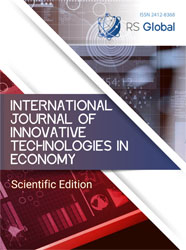RELATIONSHIP BETWEEN EXCHANGE RATE AND FOREIGN EXCHANGE RESERVES
Abstract
The main objective of this study is to examine the existence and nature of the relationship between the exchange rate and foreign exchange reserves. To avoid influencing foreign exchange market expectations, the intervention program should indicate in advance the nature, frequency, and size of the central bank's foreign exchange transactions. Thus, in this sense, it is essential to determine the nature of the relationship between the exchange rate and the interventions made from and for the official foreign exchange reserve. Following the realization of this study, it was highlighted the conclusion that through the application of Johansen cointegration tests, between the pairs of variables - NEER and the interventions from/for the foreign exchange reserve; official exchange rate and interventions in/for the foreign exchange reserve - there is at least one cointegration relationship. That is, between the exchange rate and the interventions in/for the foreign exchange reserve, a long-term relationship is highlighted, which can facilitate the forecast.
References
Bahmani−Oskoee, M., Brown, F. (2002). Demand for international reserves: A review article. In: Applied Economics, 34, pp.1209–1226.
Bernanke, B.S. Financial Reform to Address Systemic Risk (2013). In: Speech at the Council on Foreign Relations, Board of Governors of the Federal Reserve System.Washington, DC.
Borio, C., Disyatat, P. (2011). Global Imbalances and the Financial Crisis: Link or No Link? In: BIS Working Papers, 346.
Borio, C., Galati, G., Heath, A. (2008). FX reserve management: trends and challenges. In: BIS papaers, No 40.
Calvo, G.A., Reinhart, C.M. (2002). Fear of floating. In: The Quarterly Journal of Economics, 117, pp. 379–408.
Canales-Kriljenko, J.I. (2003). Foreign Exchange Intervention in Developing and Transition Economies: Results of a Survey. In: IMF Working Paper, 03/95, 2003.
Cheng, T., Liu, X. (2013). Foreign exchange reserves: A new challenge to China.In: Journal of Post Keynesian Economics, 2013, 35, pp.621–650. ISSN 0160-3477.
Currency Composition of Official Foreign Exchange Reserves (COFER), International Financial Statistics (IFS) [online]. https://data.imf.org/?sk=E6A5F467-C14B-4AA8-9F6D-5A09EC4E62A4
Disyatat, P., Galati, G. (2007). The effectiveness of foreign exchange intervention in emerging market countries: Evidence from the Czech koruna. In: Journal of International Money and Finance, 26, pp.383–402.
Fry−Mckibbin, R.A., Wanaguru, S. (2013). Currency intervention: A case study of an emerging market. In: Journal of International Money and Finance, 37, pp. 25–47.
Hausmann, R., Panizza, U., Stein, E. (2001). Why do countries float the way they float? In : Journal of Development Economics, 66, pp. 387–414.
International Reserves and Foreign Currency Liquidity International Reserves and Foreign Currency Liquidity. (2013). Washington, DC: IMF.
Mohanty, M.S. (2013). Market Volatility and Foreign Exchange Intervention in EMEs: What Has Changed: An Overview. In: BIS Papers 73.
Nugee, J. (2009). Foreign Reserves management. In: Centre for Central Banking Studies, Bank of England, Handbooks, No.19.
Sarno, L., Taylor, M.P. (2001). Official intervention in the foreign exchange market: Is it effective and, if so, how does it work? In: Economics Letters, 39, pp. 839–868.
Yeonjeong, L., Seong-Min, Y. (2020). Relationship between International Reserves and FX Rate Movements. In: Special Issue "Application of Quantitative Methods in Modelling Sustainability in Economics and Finance".
Views:
497
Downloads:
338
Copyright (c) 2022 Viorica Lopotenco, Dziubetcaia Tatiana

This work is licensed under a Creative Commons Attribution 4.0 International License.
All articles are published in open-access and licensed under a Creative Commons Attribution 4.0 International License (CC BY 4.0). Hence, authors retain copyright to the content of the articles.
CC BY 4.0 License allows content to be copied, adapted, displayed, distributed, re-published or otherwise re-used for any purpose including for adaptation and commercial use provided the content is attributed.











